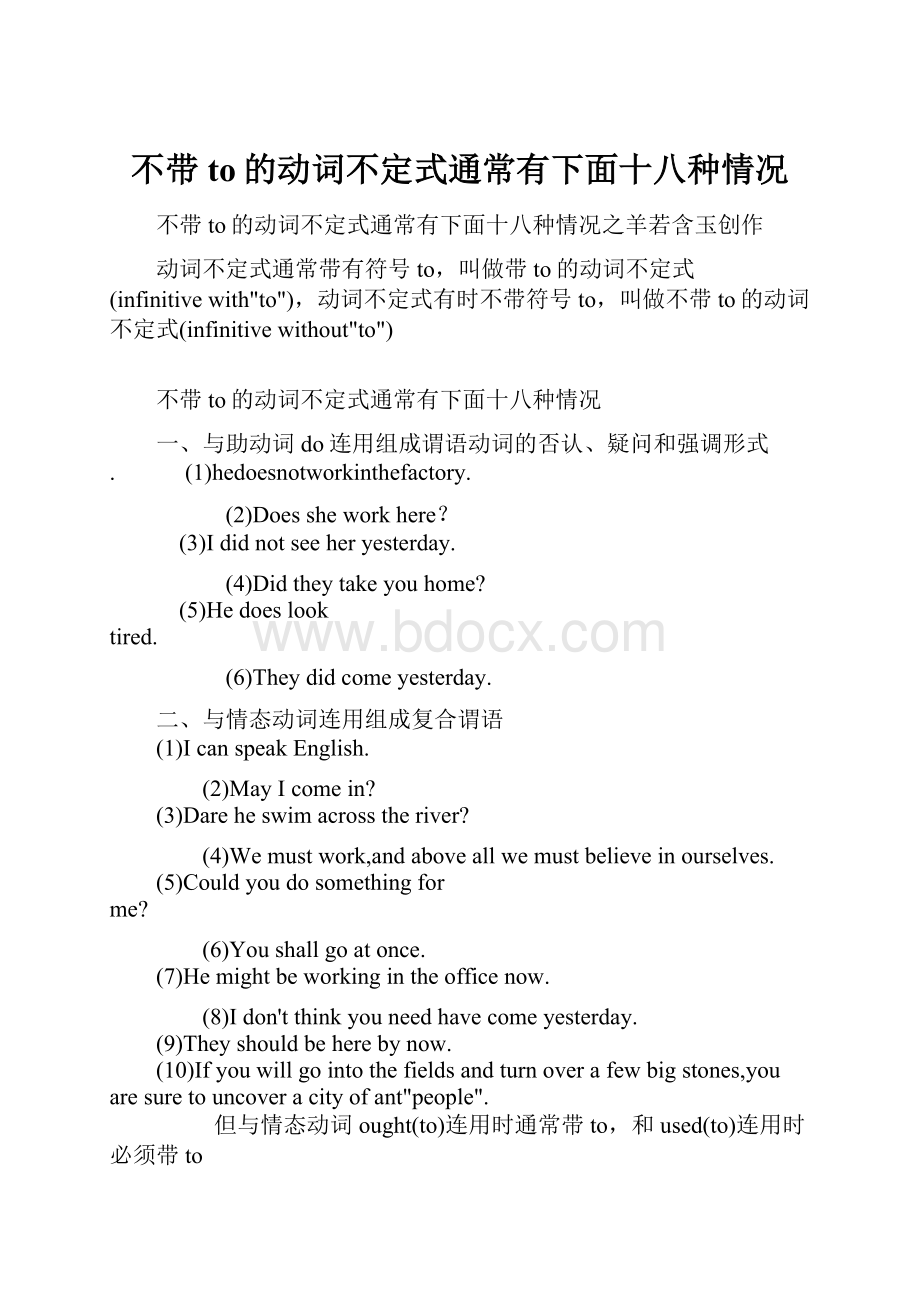不带to的动词不定式通常有下面十八种情况.docx
《不带to的动词不定式通常有下面十八种情况.docx》由会员分享,可在线阅读,更多相关《不带to的动词不定式通常有下面十八种情况.docx(6页珍藏版)》请在冰豆网上搜索。

不带to的动词不定式通常有下面十八种情况
不带to的动词不定式通常有下面十八种情况之羊若含玉创作
动词不定式通常带有符号to,叫做带to的动词不定式(infinitive with"to"),动词不定式有时不带符号to,叫做不带to的动词不定式(infinitivewithout"to")
不带to的动词不定式通常有下面十八种情况
一、与助动词do连用组成谓语动词的否认、疑问和强调形式.
(1)hedoesnotworkinthefactory.
(2)Doesshe workhere?
(3)Ididnotseeheryesterday.
(4)Didthey takeyouhome?
(5)Hedoeslooktired.
(6)Theydidcome yesterday.
二、与情态动词连用组成复合谓语
(1)IcanspeakEnglish.
(2)MayIcomein?
(3)Dareheswimacrosstheriver?
(4)Wemustwork,and aboveallwemustbelieveinourselves.
(5)Couldyoudosomethingforme?
(6)Youshallgo atonce.
(7)Hemightbeworkingintheofficenow.
(8)Idon't thinkyouneedhavecomeyesterday.
(9)Theyshouldbeherebynow.
(10)Ifyouwillgointothefieldsandturnoverafewbig stones,youaresuretouncoveracityofant"people".
但与情态动词ought(to)连用时通常带to,和used(to)连用时必须带to
三、在暗示感到的动词如:
see,look.at,watch,hear,listen
to,feel,notice,observe,perceive(发觉,看见),behold(书面用语“见到”)等后用作宾语补足语的动词不定.
(1)Isawhercrossthestreet.
(2)Helooked atthechildrenwalkupthehill.
(3)Iwatchedtheboycrosstheroad.
(4)Iheardher playthepiano.
(5)Helistendtoustalk.
(6)Ifeltthe floormove.
(7)Ididn’tnoticeyouenter.
(8)Heobservedsomeoneopenthedoor.
(9)Ididnotperceiveanyonecomein.
(10)Hebeheld hergoout.
但除notice,watch不必主动语态外,上述动词变成主动语态时,其后的动词不定式就不省to
(1)Shewasseentocrossstreet.
(2)Shewas heardtoplaythepiano.
四、使役动词make,let,have,bid,leave(=let)后作宾语补足语的动词不定式不带to
(1)Youmaytakeahorsetothewater,butyoucan'tmakehimdrink.
(2)I'lllethimdoit.
(3)Don'tforgettohavethemcome.
(4)Bidhimgohome.
(5)Leavehimgo.
动词have通常不必于主动语态,make和bid可用于主动语态,let偶然也可用于主动态,用作主语补足语的动词不定式通常带to,但在make和let后有时可以不带to
(1)Johnwasmadetowashthetruckforaweekasapunishment.
(2)Hewasmade(to)laugh.
(3)Thechildwaslet(to)doit.
五、never与know连用其后作宾语补足语的动词不定式可省to,其时态多为完成时态.
(1)Ineverknewhimactwithoutthinking.
(2)I'venever knownitsnowinJulybefore.
(3)Ihadneverknownheraskforpitybefore.
有时ever与known连用也有上述用法.
(1)Haveyoueverknownmetella lie?
六、在find后作宾语补定语的动词不定式有时可以省to,但如动词为be,那么一般不省to,要省一起省略"tobe"
(1)Wefoundthefarmcrops(to)dowell.
(2)Ifindthe Chinesepeopletobehappyandcheerful.
(3)Ifoundthistobetrueinallthecities.
(4)We foundhim(tobe)honest/dishonest.
七、在cannotbut,cannothelpbut,cannotchoosebut,hadbetter(best),would(had)rather(sooner)…than…,wouldas
soon…as…后的动词不定一般不带to
(1)Whenthecountrycallsyouforhelp,youcannotbutgo.
(2)Hecan'thelpbutfeelsorryforher.
(3)hecannotchoosebutobey.
(4)Ihadbetterleavenow,orI'llbelate.
(5)Hehadbestbuyitnowwhileitisstillavailable.
(6)Iwouldrathergomountain—climbingthanjusttakeawalk.
(7)Myauntinvitedmetothemovies,butIsaidIhadrathergoona picnicwiththegirls.
(8)Ihadsoonerliveonafarmthaninthecity.
(9)Hewouldsoonerresignthantakepartinsuchdishonestbusiness deeds.
(10)I'drathernottellyou.
(11)Hesaidhe'dsoonerdiethanbetrayhisfriend.
八、在but(=except),besides,than后的动词不定式一般要带to,但如果其前有作谓语的实义动词do,则不定式不带to
(1)Thesoldierhasnochoicebuttoobey.
(2)He didnothaveanychoicebuttoobey.
(3)Shedidnothingbutcleanthedishes.
(4)Thechildrenfoundtherewasnothingtheycoulddowiththeirmoney,exceptspenditonsweets.
(5)Thereseemednothingelsetodo but(to)sendforadoctor.(but前的实义动词do不作谓语,but后的不定式可带to,也可不带to)
(6)Hedidnothingelsethanlaugh.
(7)Icouldhardlydolessthanwait.
九、不定式作表语时,如主语部分含有实义动词do,且句子的时态为一般现在时或一般曩昔时(多为is或was),不定式可以带to也可不带to
(1)Whatwemustdonowis(to)findantherpersontohelpus.
(2)Allhecoulddowas(to)rushintotheroom.
如句子的动词时态不是一般现在时或一般曩昔时,作表语的动词不定式一般要带to
(1)Sheknewthatallshewouldhavetodowouldbetostopcrying.
十、ratherthan位于句首时,其后用不带to的不定式,但rather
than在句中时,其后的动词不定式可以带to,也可以不带to
(1)Ratherthanrideonacrowdedbus,healwayspreferstorideabicyde.
(2)Ratherthancausetrouble,heleft.
(3)Hepreferstorentacarratherthan(to)haveoneofhisown.
十一、在动词help后作宾语补足语的动词不定式可以带to,也可以不带,在英国英语中,多用不带to的不定式,但在英国英语中,help+宾语+不定式构造中,用不带to的不定式暗示主语直接介入不定式的暗示的动作,用带to的不定式暗示主语没有直接介入不定式的暗示的动作.
(1)Hehelpedmerepairthebicycle.
(2)Hehelpedmetorepairthebicycle.
(3)Thiskindofsoaphelpsustowashtheclothesmoreeasily.
(4)ThebookwillhelpyoutostudyEnglish.
但在主动语态中,help后的不定式要带to
(1)Shewashelpedtorepairherbicycle.
在help(to)dosth不定式符号to可省略.
Hehelped(to)repairthemachine.
十二、两个或两个以上的动词不定式并列在一起时,第一个不定式带to,后面的不定式一般省去to
(1)Herjobistotakecareofthechildrenandwashclothes.
(2)Thegirldoesn'tknowhowtoreadandwrite.
但如果是在对比场合,则不省去to
(1)Itisbettertolaughthantocry.
(2)Thepurposeofnewtechnologiesistomakelifeeasier,notto makeitmoredifficult.
十三、than衔接两个动词不定式没有比较关系时,后一个不定式可以省to
(1)Youmightdoworsethan(to)doashedoes.
(2)Icannotdobetterthan(to)getawayforthefewdays.
下面句子中than衔接的不是两个动词不定式than后的动词不定式通常要带to
(1)Iknowbetterthantobelievehim.
(2)Thebeatenenemyhadnochoicethantosurrender.
下句中的morethan(=only)可以算作复合副词,后面的动词不定式不带to
(1)Ididnotmorethanmakeabeginning.
十四、在why,whynot后的不定式不带to
(1)Whyspendsuchalotofmoney?
(2)Whynotjoin us?
(3)Whydon'tyousmoke?
十五、实义动词dare在现代英语白话中,其所在的否认句或疑问句中,它后的动词不定式可省to,尤其在一般曩昔时中
(1)Doeshedarego?
(2)Wedonotdare speak.
(3)Hedidnotdarego.
(4)Didhedare go?
(5)Hedaredgo.
(6)Daredhego?
(7)Heknewshedarednotopenhismouth.
十六、在白话中,特别是在美国,祈使语气谓语动词和组成谓语的不定式go后面的不定式往往不带to
(1)Goaskher.
(2)I'llgoseemybrother. 这种用法在英国白话中比较少见,一般在动词go后用连词and
(1)GOandaskher.
(2)I'llgoandsee mybrother.
十七、在"willyouplease…?
"和wouldyouplease…?
句型中,要用不带to的不定式.
(1)WillyoupleasegivethenotetoTom?
(2)Willyou pleaseopenthewindow?
(3)Wouldyoupleasegivemeahand?
十八、Better+动原(白话中用)
(1)Betteraskthemgoastray.
(2)Bettergoat once.